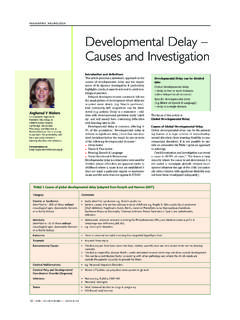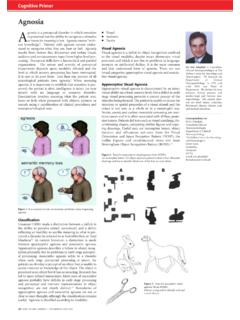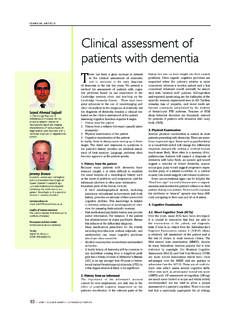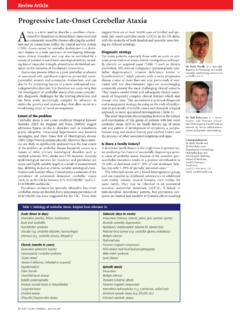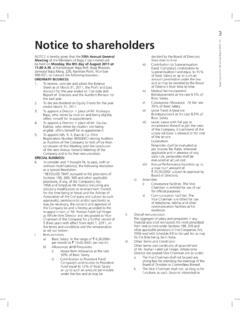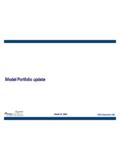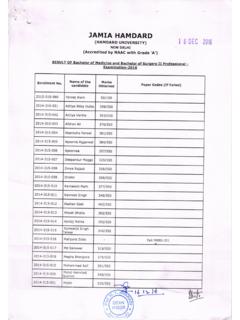Transcription of SWEDD for the General Neurologist
1 30>ACNR>VOLUME 10 NUMBER 4 >SEPTEMBER/OCTOBER 2010 Nin Bajajgraduated in medicine fromOxford University after pre-clinical training at Cambridge. Hewas a Wellcome clinical trainingfellow in the molecular modellingof neurodegenerative diseases atThe Institute of Psychiatry,London, and his subsequent neu-rology training was undertaken atthe National Hospital forNeurology and King's Hospital,London. He was appointed ConsultantNeurologist at NottinghamUniversity Hospitals in 2002, spe-cialising in movement disorder. Hewas the Lead Clinician for theHospital Doctor Parkinson'sDisease team of the year in bajaj is currently ClinicalDirector of the National ParkinsonFoundation Centre of Excellencein PD between Derby HospitalsNHS Foundation trust and theUniversity of ongoing research interests arein SWEDD , and the application ofhigh field MRI and proteomics inthe diagnosis of movement disor-ders and allied to:Nin bajaj , MA, FRCP, PhD,1 21 Department of Clinical Neurology,Nottingham University HospitalsNHS Trust, Nottingham, UK.
2 2 Department of Clinical Neurology,Derby Hospitals NHS FoundationTrust, Derby, spring morning in a LondonSquare was the setting of the first everSWEDD-UK meeting. The event was madepossible with generous support from theDementias and Neurodegenerative diseases net-work (DeNDRoN).Many of you will be forgiven for never havingheard of SWEDD . This article, summarising the pro-ceedings of the meeting, and detailing the aims ofthe UK consensus group, should tell you all youneed to know. For those of you who want to knowmore, there has been a detailed recent is a SWEDD and why should I care?Scans without evidence for dopaminergic deficit( SWEDD ) is the term originally coined to describea group of patients that puzzled the movement dis-order establishment.
3 At the time this term was com-ing into use, a number of studies comparing post-mortem diagnosis of Parkinson s disease with theclinical diagnosis in life had already confirmed ourwidely held belief that our clinical skills wereexcellent and indeed, over the course of studiesheld a decade apart, were ,3A number of clinical trials held against this back-drop of high confidence in our clinical diagnosticskills, were attempting to use nuclear medicalimaging techniques [18F-dopa PET or -car-bomethoxy-3 -(4-iodophenyl)nortropane singlephoton emission computed tomography ( -CITSPECT)] as a biomarker to assess disease 6 The use of these imaging techniques as dis-ease biomarkers in PD has since come under con-siderable criticism, but the role of these techniquesin distinguishing PD from benign tremor disordershas been endorsed, inter alia, by trialsall sought to recruit patients with PD, either relative-ly early or later in the disease course, referred frommovement disorder specialists in the USA, UK andEurope.
4 The trials organisers were surprised to notea consistently high normal functional imagingscan ranging from 4% for later disease course trialsto 15% for early disease course trials. Initially anumber of explanations were considered toexplain this anomaly, including poor diagnosticaccuracy of the scans and poor diagnostic accura-cy of the clinicians. Subsequent long term follow-up of these patients however was notable for no ini-tially normal scans becoming abnormal with timeand for blinded clinician review of the video-tapeof patients confirming the initial clinical presump-tion that these patients looked like they had ,9 Furthermore.
5 More recent olfaction studies haveshown near normal olfaction scores in SWEDD spatients whereas PD patients are notable forimpaired olfactory number of studieslooking at diagnostic accuracy of SPECT scanninghave also confirmed a high clinical concordancebetween the scan findings and clinical opinionwith sensitivity (93%) and specificity (95%) ofdetection of the pre-synaptic dopaminergic deficittypical of the term SWEDD is relatively recent inusage and has emerged from the clinical trial liter-ature, clinicians have always been aware of PDmimics where the parkinsonism is not of a pre-synaptic, dopaminergic deficiency origin.
6 Thus theterm SWEDD can really be levelled at any patientthat looks as if they have PD but where subsequentfunctional imaging assessments do not confirmthis. SWEDD phenotypes will therefore vary inmuch the same way as PD phenotypes do. Thereare two broad PD phenotypes, akinetic-rigid (alsoknown as postural instability gait disorder variant-PIGD) and tremor dominant (also known as tremu-lous PD).12In the same way, SWEDDs patients canbe subdivided into tremor dominant and non-tremor dominant (or tremor absent) subtypes are summarised in Tables 1 and causes of SWEDDs are sufficiently uncom-mon to be rare causes of clinical mis-diagnosis out-side the most specialised of units.
7 It is the commoncauses of SWEDDs that the clinical readers of thisarticle need to be most wary of. Some commoncauses of SWEDDs give other clues- vascularparkinsonism is relatively common but most casesof vascular parkinsonism do not look like typicalPD. The classic vascular PD case may have step-wise progression (reviewed in 13), be predominate-ly lower body, show no response (or poor responseat standard doses) to leva-dopa and have an MRIbrain showing extensive leukoariopathy especiallyin the basal ganglia. Tardive cases are common butare usually referred from concerned psychiatristsand are obviously on neuroleptic drugs similarlya drug history of valproate exposure requires littledetective work to come up with this as a diagnosticconsideration.
8 The commonest cause of SWEDD that wouldtrouble the General Neurologist and even the move-ment disorder expert are those harbouring atremulous but benign condition where parkinson-ian features are a common occurrence. This iswhere adult onset dystonic tremor, indeterminatetremor and perhaps essential tremor (ET) need tobe considered. Whether ET should be consideredat all as a cause of SWEDD is controversial, andindeed was one of the topics debated by ourexperts in the SWEDD -UK meeting (see proceed-ings following), but there is sufficient reference tothis in the current literature that for the moment,we have retained it.
9 Under the 1998 MovementDisorder Consensus Statement on EssentialTremor,14other neurological features dystonia,are exclusion criteria for definite ET and thus ETmasquerading as SWEDD should not occur, butgiven the prevalence of ET, dual pathology withparkinsonism secondary to the ageing process,cerebrovascular disease or concomitant medica-tions, is likely to for theGeneral NeurologistSPECIAL FEATURE ACNR>VOLUME 10 NUMBER 4 >SEPTEMBER/OCTOBER 2010>31As a proof of principle that tremulousSWEDDs patients are the really troublesomediagnostic conundrums and to emphasise clin-ical diagnostic error rate, we recently assessedthe ability of two of the UK s leading movementdisorder experts to clinically distinguish a seriesof tremulous SWEDDs from TDPD on blindedvideotape analysis.
10 Many will argue that video-tape analysis is not the same as seeing a patientin clinic, but we already know from the SWEDD literature that even seeing patients in person, inthe clinic setting, can give a false positive errorrate of up to 15% for PD. Furthermore, video-tape diagnosis of movement disorder is some-thing that we experts indulge in at numerousvideo Olympics sessions held around the worldand there is a literature validating the diagnos-tic accuracy of video how did our experts do? Well, you cansoon read for yourself but with a specificity forthe diagnosis of PD ranging from 79-85%, andsensitivity of 72-93%, their performance wasrespectable but not as good as either of themwould have spare the blushes of ourexperts, the entire audience at the British andIrish Movement Disorder Meeting in London2009, and the assembled panel at SWEDD -UKwere subjected to similar blinded analysis oftremulous parkinsonian patients.
